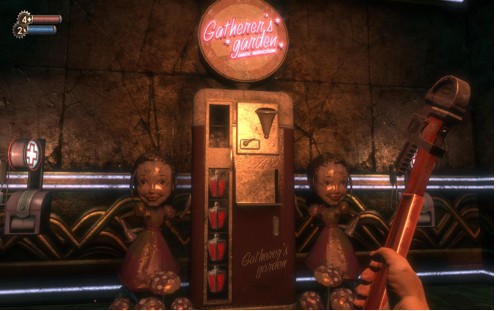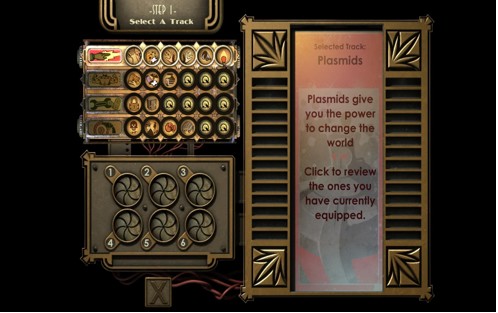Shoot, Strafe, Soliloquy: A Crisis in Videogame Narratives
The fall from Rapture
'We all make choices, but in the end our choices make us.'
Andrew Ryan (Bioshock)
This brings me to the final coordinate of this dissertation: how can videogames overcome this impasse? I believe that the modern FPS BioShock (2007) provides a self-conscious interrogation of this contemporary crisis of form. Ken Lavine, a leading figure in contemporary game design and architect of BioShock recently stated that 'I don't start with story, because games are not story. Games are gameplay' (7). It is ironic, then, that BioShock has consistently been hailed as a work of narrative genius. Four years after its initial release, it is still regarded by many critics as the pinnacle of narrative achievement within the gaming art form. The influence of BioShock has been so immense, that many of the avant-garde techniques it utilises to produce engaging 'drama' have been swallowed whole by development studios around the world. This begs the question, how is BioShock's diegesis distinct from Half-Life 2 and Deus Ex?
At the heart of the gaming industry's obsession with BioShock is its overt exploration of the tension between its form and content. As previously discussed, the search for narrative perfection in videogames has been pursued by attempting to integrate active engagement with passive observance, game mechanic with narrative perspective. The achievement of this dynamic has become the holy grail of game development. BioShock utterly explodes these conventional aspirations by openly deconstructing and interrogating the 'narrative versus play' paradigm. In the process of wrestling with these canonical conceptions, BioShock proposes the notion that the user's input is minimal, their choices irrelevant, their sense of narrative order a lie, and their agency an illusion. In a Brechtian moment of meta-mediality, BioShock lifts up the veil of its own performance to comment on the restrictions inherent in its form. In this respect, Bioshock addresses the vital aspect of the contemporary crisis the gaming industry faces: where do we go from here?
'I chose something different. I chose the impossible. I chose... Rapture.'
Andrew Ryan, Bioshock (2007)
BioShock is a linear FPS with RPG elements. A synopsis of its plot can be drawn as follows: you are Jack, a passenger aboard a commercial plane that crashes in the Atlantic. After a miraculous survival you descend into an underwater city called Rapture, a city evidently modelled as a sublime double of 1950s capitalist America. The inhabitants have been driven insane through the excessive use of a substance called ADAM. Rapture's whole economy and society is linked to ADAM, a chemical agent that allows an individual's genetic code to be re-written. Misuse of ADAM and different factions grappling for power resulted in civil war between two factions lead by Andrew Ryan and Frank Fontaine respectively. The resulting chaos has half destroyed the city: breached bulkheads spill water everywhere, and the remaining inhabitants are homicidal lunatics known as 'splicers'[i]. It is the player's objective to find a method of escaping Rapture with the help of their only known ally, Atlas. Naturally, this leads to confrontations with the few remaining powerful figures that survived Rapture's descent into madness, including the city's founder and insidious controller, Andrew Ryan.
This narrative environment serves as a highly complex metaphor for the gaming situation at large. [Please refer to V. D1] As Andrew Ryan's introductory video demonstrates, Rapture is a city of ideological difference, positioning itself as an antithetical model to the conventional surface world of 'Gods and Kings' (Bioshock). His disgust for the surface is expressed in terms of limitation, Ryan cannot accept the perpetual constraints of life above water, where social rules and boundaries restrict personal liberties. As the player descends into a foreign, submarine environment, Ryan promises himself, and them, the freedom to 'choose the impossible'. In the same manner, videogames are predicated on a fundamentally different ontological system to older, interpretive media; they exist and grow through play, configuration, and experimentation - a dynamic compellingly compatible with the ideological organization of Rapture. Therefore, the player's journey through this city functions on several meta-layers: they are playing a game that mirrors real-world society, but that society in turn mirrors the act of playing itself.
[V. D1] Jack's entry into Rapture at the beginning of BioShock
In this manner, BioShock projects a complex reading of a medium in crisis; Rapture is a violent dystopia. Appropriately, the player is invited to participate in the cause of this crisis, ADAM. The metaphorical and literal currency of Rapture, ADAM is the dream substance of individualism; every member of society has the opportunity to become their 'ideal self', both physically and mentally. Vending machines that dispense ADAM litter the cityscape of Rapture with promises of self improvement, each machine announcing that "My daddy's smarter than Einstein, stronger than Hercules, and lights a fire with the snap of his fingers! Are you as good as my daddy mister?" (BioShock) In this environment of genetic modification the player must find ADAM, as well as plasmids (items that allow ADAM to produce specific modifications such as telekinesis or invisibility), in order to survive. Although the player's choice of plasmids can in no way affect the narrative trajectory, the system of customisation it provides requires the player to enter into Rapture's society of 'choices'.
As the player crosses the threshold into Rapture, Jack is essentially a tabula rasa, and thereby provides the ideal vessel for players to begin constructing their 'ideal self' within the confines of the game mechanic. The ludic attributes of Jack are blank (he possesses no ADAM or weapons) and the player must decide how they wish to customise their surrogate. Separate screens that temporarily displace the first person perspective allow the management of a complex 'plasmid slots'. The player switches between these perspectives: fighting with plasmids in first person and managing them along with his weapons in the abstract inventory pages. [Please refer to figures 6.1 and 6.2] Although this configurative mode of 'play' is usually disconnected from the narrative proper, in BioShock it functions as a mirror of the surrounding environment.

[Figure 6.1] A Gatherer's Garden ADAM dispenser in BioShock

[Figure 6.2] One of BioShock's screens for configuring plasmids and other modifications.
Indeed, Rapture's failed vision is always drawn in terms of 'choosing': each adversary's lunacy manifests through an obsessional dissatisfaction regarding representation and configuration, impossible perfection and human limitation. [Please refer to V. D2] Dr.Steinman and Sander Cohen are two powerful Rapture residents the player encounters. It is revealed that before the game began Steinman was a plastic surgeon and initially used
[V. D2] Dr.Steinman and Sander Cohen's madness.
ADAM to sculpt his patients' features into conventionally pleasing shapes. However, ADAM allowed him to change the configuration of each face with such ease, that he became tired of 'creating the same tired shapes over and over again: the upturned nose, the cleft chin, the ample bosom (BioShock). ' The propagation of possibilities ADAM presented to Steinman merely highlighted the restrictions inherent in his 'art form'. As Steinman slowly lost his mind, he turned to Picasso for inspiration, attempting to breach the formal structures enclosing his art by committing hideous cubist surgeries. As V. D2 demonstrates, he is never sated, feeling forever trapped by the insufficient variance in his handiwork.
Similarly, Sander Cohen (formerly Rapture's foremost artistic scholar) is obsessed with constructing the perfect frieze. Long since mad, Cohen has 'preserved' many of his splicers in plaster as perpetual sculptures. When traversing Fort Frolic, Cohen tasks the player with dispatching former 'disciples' who have displeased him, photographing them, and arranging the stills in a sculpture for his pleasure. [Please refer to figure 6.3] This chilling combination of ludic combat and 'artistic' compilation is an overt gesture toward the wider question of Cohen's madness: like the horrifically entombed splicers, must videogames sacrifice their dynamic mobility in order to function as representational structures? Traditional aesthetics no longer satisfy Cohen: in desperation for originality, his desires oscillate between the dynamic movement of theatre and immutability of sculpture. Even Cohen's attempts to kill the player mutate into a theatrical performance. As his splicers attack, jovial classical music blares throughout Fort Frolic and a spotlight shines on the player, transforming the skirmish into a piece of macabre theatre which is part dynamic, part orchestrated.
Though consistently exposed to the rhetoric of choice, the players encounters with these antagonists brings the carefully constructed nature of their experience into sharp focus. The conflict of ideologies in BioShock does not merely interrogate paradigms of social freedom, but also the foundational structure of the videogame form. In Rapture, form and substance no longer 'constrain' the bounds of human endeavour, just as videogames are both configurative and representational. However, like Steinman and Cohen, is the gaming canon on the road towards terminal confusion? Steinman best describes implications of such a hypothesis when he asks, 'what if now it is not my skill that fails me... but my imagination?' (Bioshock)
